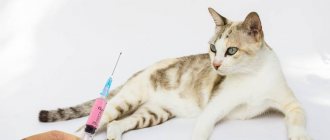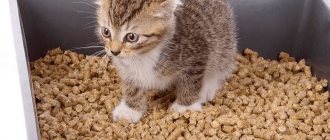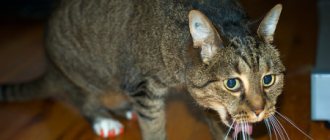The danger of contracting infectious diseases awaits pets everywhere. Due to their behavior - catching a mouse or a street pigeon while playing - cats are at high risk of contracting such a serious infection as salmonellosis. An infection that, based on its initial manifestations, can be mistaken for banal poisoning or another viral disease.
Cunning and the danger of infection
This is the insidiousness of salmonellosis. The manifestation of early clinical symptoms when infected with this infection is similar to the signs of a viral disease such as panleukopenia - “feline distemper”:
- the animal becomes lethargic, constantly hides in secluded places, almost never leaving them even to eat or drink;
- body temperature reaches critical levels;
- vomiting and diarrhea appear;
- There may be blood in the feces.
Salmonellosis in cats is a bacterial infection caused by Salmonella. The disease develops very rapidly and can be fatal. The characteristics of the pathogen, Salmonella bacteria, are that they are extremely persistent and survive in the most unfavorable environmental conditions. At low or high temperatures they remain viable for a long time.
For timely assistance and prescribing antibacterial therapy, it is very important not to confuse the disease. At the first suspicion of this bacterial infection, laboratory tests should be performed to confirm the diagnosis.
Symptoms of salmonellosis in cats
Salmonellosis in cats is severe. Animal owners should be alert to the following signs:
- lack of appetite;
- attacks of severe intermittent fever;
- temperature increase;
- frequent vomiting with foam, including after drinking water;
- apathy;
- in some cases, severe profuse diarrhea with a fetid odor, dark, almost black feces, and streaks of blood;
- cough and difficulty breathing.
Due to severe pain in the abdominal area, the cat does not allow its sides to be touched, runs away, can hiss and even show aggression. If measures are not taken in a timely manner, the animal can quickly die from dehydration or sepsis (with salmonellosis, the permeability of the vascular walls increases, resulting in an increased risk of pathogenic and opportunistic microorganisms entering the general bloodstream). Salmonellosis is extremely dangerous for kittens. If time is lost and the necessary measures are not taken, the animals may die within 1–2 days.
Diagnosis of infection
Due to the fact that salmonellosis has non-specific symptoms in cats and its manifestations are similar to other viral or bacterial diseases, special studies are first carried out. A cat should be checked for salmonellosis using a number of tests that are carried out in the laboratory of a veterinary hospital:
- clinical tests of the animal’s blood and urine are needed to confirm the presence of a bacterial infection and check kidney function;
- biochemical blood parameters allow you to assess the severity of damage to the liver and pancreas;
- The condition and size of the animal’s internal organs are examined using an ultrasound machine.
Only after a bacteriological examination of the cat’s feces and identification of the causative agent of the disease in them can an accurate diagnosis be made.
Sources of infection
Salmonellosis in cats can occur:
- after eating milk or raw meat of infected farm animals or birds;
- when eating other contaminated food, eggs, fish;
- from cats - carriers of infection through contact with their feces;
- after contact with other infected animals - rodents, birds;
- due to improper care and non-compliance with hygiene rules;
- due to reduced immunity during the period of teeth change, due to past diseases of the gastrointestinal tract, the presence of worms;
- in kittens in utero through the placenta from a sick pregnant cat.
What should you know about salmonellosis?
Salmonellosis
– a disease caused by gram-negative facultative anaerobic bacteria belonging to the genus Salmonella. Species such as Salmonella paratyphi and Salmonella typhi, which cause “typhoid-like” forms of the disease, pose a danger to humans.
In addition, there are many types of salmonella that pose a danger to animals. They enter the body with contaminated food or water. Thus, in cats, salmonellosis can occur as a result of eating raw contaminated meat, milk and eggs, or contact with the feces of sick animals. Quite often, outbreaks of salmonellosis among cats occur in areas located near poultry houses, farms, meat processing plants, slaughterhouses, and burial sites for animal remains.
Incubation period and development of the disease
After entering the body, the causative agents of salmonellosis begin to multiply and poison the host with the products of their vital activity - endotoxins. As a result, an inflammatory process occurs in the intestines.
Toxins accumulate in the body and affect the vessels of the intestinal wall, increasing its permeability. If the cat's body has insufficient resistance, endotoxins:
- cause areas of hemorrhage on the mucous membranes;
- provoke degenerative changes in organs - intestines, liver, kidneys, spleen;
- penetrate the body’s lymphatic system and general bloodstream, causing the development of sepsis - blood poisoning;
- affects all organs and systems - the brain, joints, lungs.
When bacteria infect all organs and tissues of the body, liver, kidney, and pulmonary failure develops and the death of the animal occurs.
The incubation period after infection ranges from several days to three weeks. The appearance of the first signs of manifestation may be acute or resemble the malaise of mild poisoning. It depends on the age of the pet. The infection is extremely dangerous for kittens, as they tolerate it extremely hard and can die on the second day of illness.
The disease is extremely contagious. If there are other pets in the house besides the cat, they must be isolated. In dogs, the symptoms that occur when infected are the same.
The course of the disease, its severity and the form of salmonellosis depend on the stability of the cat’s immunity.
Forms of the disease
There are acute forms of the disease, subacute and chronic.
The acute form develops when a large number of bacteria - pathogens and their toxins - enter the body. It is characterized by:
- a rapid rise in temperature to very high levels. It remains high throughout the entire period of illness;
- complete refusal of food;
- almost continuous watery diarrhea, vomiting;
- purulent discharge from the eyes and nose;
Vomiting is preceded by hypersalivation. Feces may contain blood and mucus.
Frequent vomiting and profuse diarrhea threaten dehydration and severe intoxication. In this condition, the animal may die already on the second day after the onset of salmonellosis.
The subacute form develops with the same symptoms only of less intensity. Dehydration may not occur as quickly as during an acute infection.
The chronic form of salmonellosis depletes the animal's body. When poisoned by bacterial waste products, purulent conjunctivitis, pneumonia, and anemia develop. Death can occur within a month after the onset of the disease.
Description
1-2 month old kittens, whose immune system has not yet developed well enough, are at greatest risk of contracting salmonellosis.
To avoid infection, it is recommended to give vitamin preparations to kittens of this age. Salmonellosis can occur in the following forms:
- Acute - characterized by an increase in temperature up to 40 degrees, the occurrence of vomiting, diarrhea, and tearing of the eyes.
- Subacute, in which the temperature rises above 40 degrees. The animal is lethargic and refuses to eat, which leads to severe exhaustion and death within a week after infection. A symptom of the subacute form is also watery stools, sometimes mixed with blood.
- Chronic - considered the most severe form. It is accompanied by alternating attacks of diarrhea and constipation. 3-4 weeks after infection, the pet may die.
The pathogen is small rods, the length of which does not exceed 4 microns. In drinking water they remain viable for 10-120 days, in soil - 9-10 months, in room dust - up to 18 months.
Reproduction of microorganisms occurs in the small intestine. They penetrate through the bloodstream and lymph flow into parenchymal organs, where they multiply again. Their breakdown leads to the release of endotoxins. By affecting the body, they cause poisoning and irritation of the gastrointestinal tract.
First aid and treatment
Trying to cure your pet of salmonellosis on your own is dangerous for his life. A cat can die very quickly from complications developing due to infection.
At home, it is possible to provide only first aid and symptomatic therapy - treatment should only be carried out by a veterinarian.
First aid is to reduce the level of intoxication:
- The stomach is washed to remove any remaining contaminated food. The procedure is carried out only with water - about 40 ml is poured into the cat from a syringe, then vomiting is caused;
- To cleanse the intestines, do an enema with boiled water. It is necessary to pour in about 100 ml until clean water appears from the intestines;
- To neutralize the effects of toxins and remove them from the intestines, sorbents are used - Enterosgel, Activated carbon. The dose of the drug is calculated according to the instructions and depends on the weight of the animal;
- with a small volume of water, about 10 ml, the cat is given water every 15 minutes.
Treatment of the infection is complex and lasts about two weeks. It consists of the following purposes:
- hyperimmune serum to build immunity against salmonellosis;
- saline drips to combat dehydration;
- antiemetics;
- furazolidone - an antimicrobial drug active against Salmonella bacteria;
- hepatoprotectors to protect the liver from the harmful effects of powerful antibiotics;
- diet and gentle feeding of the cat.
Antibiotics and sulfonamide drugs are the main means of combating salmonellosis pathogens. Use them within a week. To provide an immunoregulatory effect, sick animals are prescribed glucocorticoids - synthetic corticosteroid hormones.
It must be remembered that immunity to this disease is not developed. A cat can become infected several times during its life. Therefore, precautions must always be present.
Prevention of infection
You need to pay enough attention to caring for animals. To protect them from the risk of infection you need to:
- keep the cat and kittens clean, always follow the rules of hygiene for them, give them only clean water to drink;
- exclude contact of your pet with street animals;
- include meat in the diet, the quality of which is beyond doubt;
- for preventive purposes, it is advisable to heat treat meat, milk and eggs;
- do not allow a sudden change from one food to another in the first days of feeding kittens;
- Buy industrial feed only of good quality.
Danger to others
Salmonellosis also poses a danger to pet owners. There is a risk of transmission of salmonella bacteria from an infected cat to humans. Therefore, after contact with a sick pet, you need to follow the rules of hygiene especially carefully:
- a sick cat should be isolated not only from other animals, but also from family members, especially children;
- disinfect those items that were used when caring for an infected cat;
- After handling a sick pet, hands should be washed twice with soap.
Even after treatment ends, the cat may remain contagious. Bacteria - pathogens - will be present in the feces. Her contact with other animals should be limited.
About carriage in cats
By solving the problem of preventing salmonellosis, owners of pet purrs ensure the safety of not only their pets, but also themselves. According to the observations of researchers, more than a third of domestic cats and dogs with good immunity do not get sick themselves after direct contact with these microorganisms, but become carriers of salmonellosis. In other words, in order to get sick, sometimes it’s enough to pet a cat and not wash your hands after that.
If we are talking about animals with weak immunity (for example, kittens, elderly cats that have recently suffered from another disease), their body may not be able to cope with the infection, and then illness is possible.











